
Product test
AMD is back on top!
by Kevin Hofer
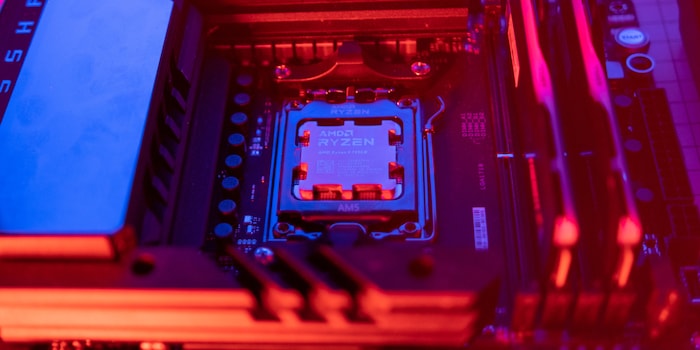
The new Ryzen 7000 processors have a lot of power. And AMD’s Eco Mode has turned out to be a real killer feature: Combining these, it’s no wonder the new flagship 7950X runs faster with the handbrake applied than its predecessor 5950X at full throttle.
95 degrees Celsius. The max temperature my Ryzen 9 7950X reached during testing. This despite my all-in-one water cooling system with a 240 radiator. Temperatures that I am not used to from AMD CPUs. Thankfully, the manufacturer does offer Eco Mode as a less straining alternative. With it, its thermal design power (TDP) can be limited from the specified 170 to 105 or even 65 watts. The result? Even limited to 65 watts, the 7950X stomps its predecessor 5950X into the ground and stays cool. Now that’s efficiency.
Eco Mode allows users to set the processor to a lower TDP. This can be done via the «AMD Ryzen Master» software or the BIOS. After that, the CPU behaves as if it was natively designed for the new TDP. For my test, I still had to adjust some things manually. This should be possible with one click in the BIOS and Ryzen Master at release.
I first limited the 7950X’s TDP to 105 and then to 65 watts before running the following benchmarks:
As usual with CPU reviews, I run benchmarks three times each and take the best result. All other settings except for the TDP are identical, and you can read them in my review of the 7950X.
I used the following components for my test:
Cinebench R23 tests how a CPU performs when rendering 3D models. The benchmark creates scores for single and multi-core performance from these calculations. I’ll only give you the result of my multi-core test, since it’s relevant in terms of performance. In single core, the CPUs require significantly less power than the possible maximum.

In Cinebench R23, the 7950X, limited to 65 watts, achieves a 3.5 per cent higher score than the 5950X with 105 watts. Nevertheless, the 7950X needs 88 watts for this. This is due to Package Power Tracking (PPT), the power limit for a socket or the actual maximum performance of Ryzen CPUs. It’s 142 watts for the 5950X. In this respect, the 7950X achieves a better result and requires 38 per cent less power. An enormous difference. With the same 105 watts (TDP), it’s a 17 per cent better score.
Limited to 65 watts TDP, the 16 cores of the 7950X run at 4.1 GHz and the CPU reaches a maximum of 50 degrees Celsius. A huge difference from the default 95 degrees. Thus, the CPU is also very well suited for smaller systems that still rely on strong computing power. Limited to 105 watts, the CPU gets to a maximum of 64 degrees Celsius and runs at 4.8 GHz on all cores.
The CPU-Z benchmark tests a CPU’s speed in both the single and multi-core mode and uses this to calculate a total score. I’ll only give you the result of my multi-core test, since it’s relevant in terms of performance. In single core, the CPUs require significantly less power than the possible maximum.

In the CPU-Z benchmark, the 7950X achieves a 33 per cent better score than the 5950X with 105 watts. At 65, the figure is still 19 per cent.
7-Zip’s built-in benchmark tests a system for compressing and decompressing data. From this, it calculates a score in giga instructions per second (GIPS). I chose the default «dictionary size» of 32 megabytes.

Here, too, the 7950X with 65 watts TDP clearly beats the 5950X by 34 per cent more GIPS. However, a comparison to the 7950X with 170 watts TDP is more exciting: with 13 per cent less GIPS, it’s a small difference. Especially when you consider that there’s still a 161 per cent gulf in PPT.
Blender Benchmark renders three scenes in its 3D graphics suite (version 3.3) and calculates three scores using them. I’ve added these up to give end scores for each.
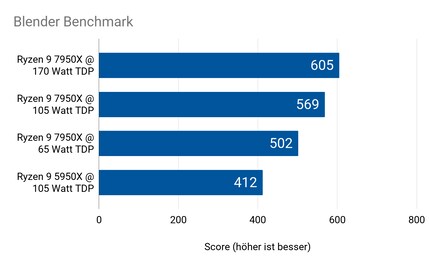
In the Blender benchmark, the difference between the 7950X with 65 watts TDP and the 7950X with 170 watts TDP is again clearer at 21 per cent. However, even the difference between the 7950X with 65 watts TDP and the 5950X is one per cent. Another clear win, given the 61 per cent less power.
For the games, I’ve also provided frame time in percentiles, namely 99 and 99.9, alongside the average frames per second (FPS). The percentile values are usually frametimes measured in milliseconds. These are the time intervals from image to image, or frame to frame. The percentile values ignore statistical outliers. 99th percentile means that 99% of all data is faster than the value provided. If a value shows as 95 fps in the graphic, 99% runs at a higher frame rate than 95 fps. Exactly 1% runs slower. The same applies to the 99.9th percentile. For a better comparison, the results of frametimes in milliseconds have been converted to conventional fps values.
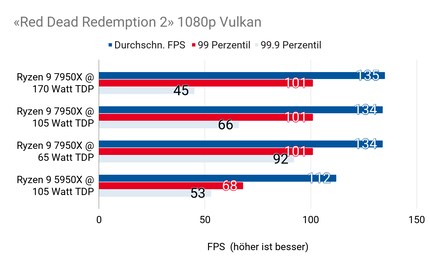
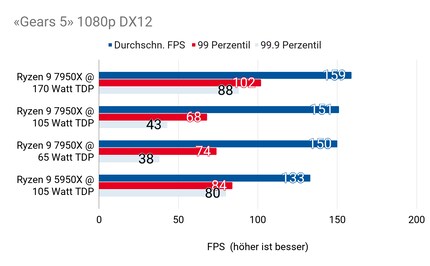
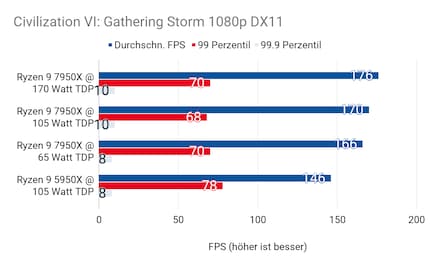
The results in-game are similar to those from other tests: the 7950X achieves more FPS than the 5950X with every TDP. When comparing among the different TDPs, differences aren’t always equally pronounced. In «Red Dead Redemption 2», the different TDPs are on par. An FPS difference is negligible. In «Civilisation VI» and «Gears 5», it can be seen FPS increases with the TDP. However, the maximum difference is only ten FPS or six per cent.
In Eco Mode, AMD delivers a feature that convinces me as a fan of small systems. Thus, hot Ryzen 7000 processors can be kept at reasonable temperatures even when ignoring cooling solutions. The fact that this also makes systems more economical, desirable in times of skyrocketing electricity prices, is more than just a nice side effect.
You do have to expect performance losses if you limit TDP. But compared with the amount of power saved, these are negligible: the biggest difference in benchmark results between the 7950X with 170 watts TDP and 65 watts is 24 per cent. Simultaneously, the difference in TDP is 161 per cent. Wow. The performance per watt is therefore enormous in Eco Mode.
What Eco Mode also shows, however: in order to achieve the high clock rates of Ryzen 7000 processors and thus keep up with Intel in terms of performance, AMD has to resort to trickery. This does bring down performance, leading to high temperatures. Something that pretty much only Intel has been known for so far.
From big data to big brother, Cyborgs to Sci-Fi. All aspects of technology and society fascinate me.